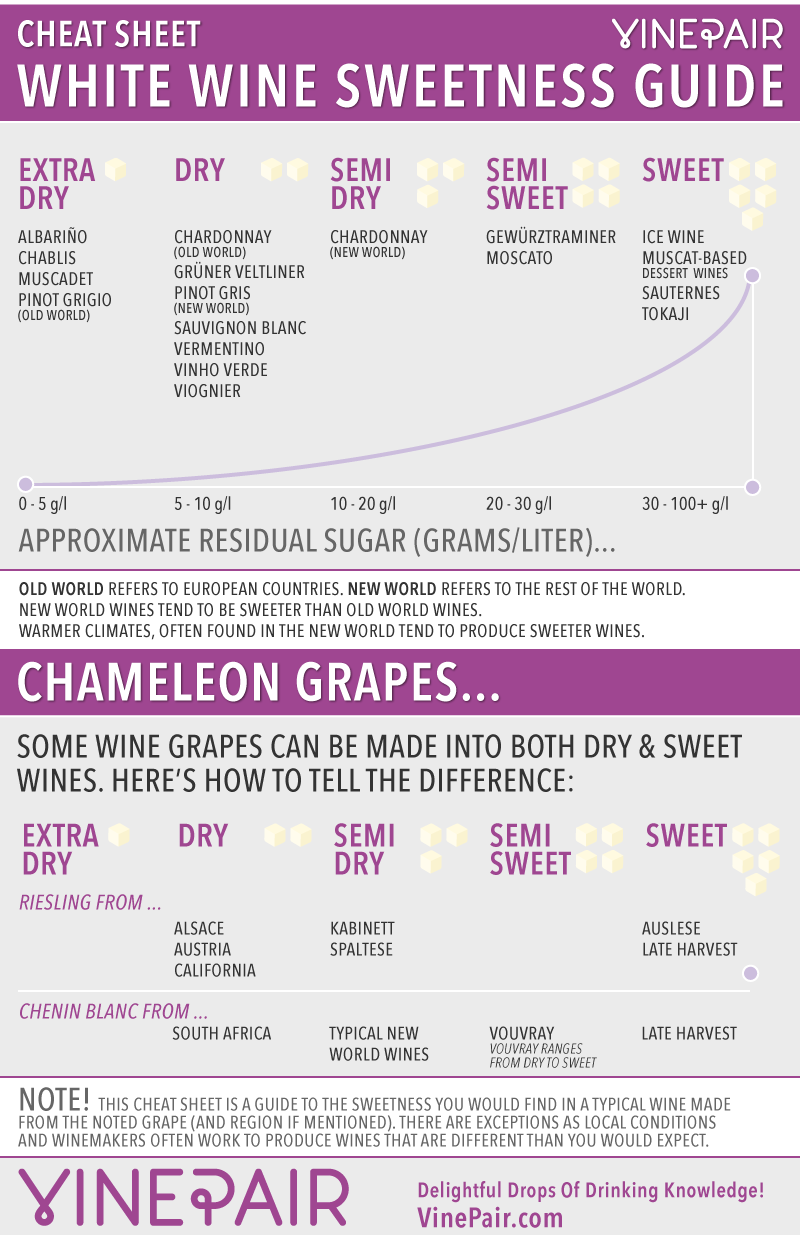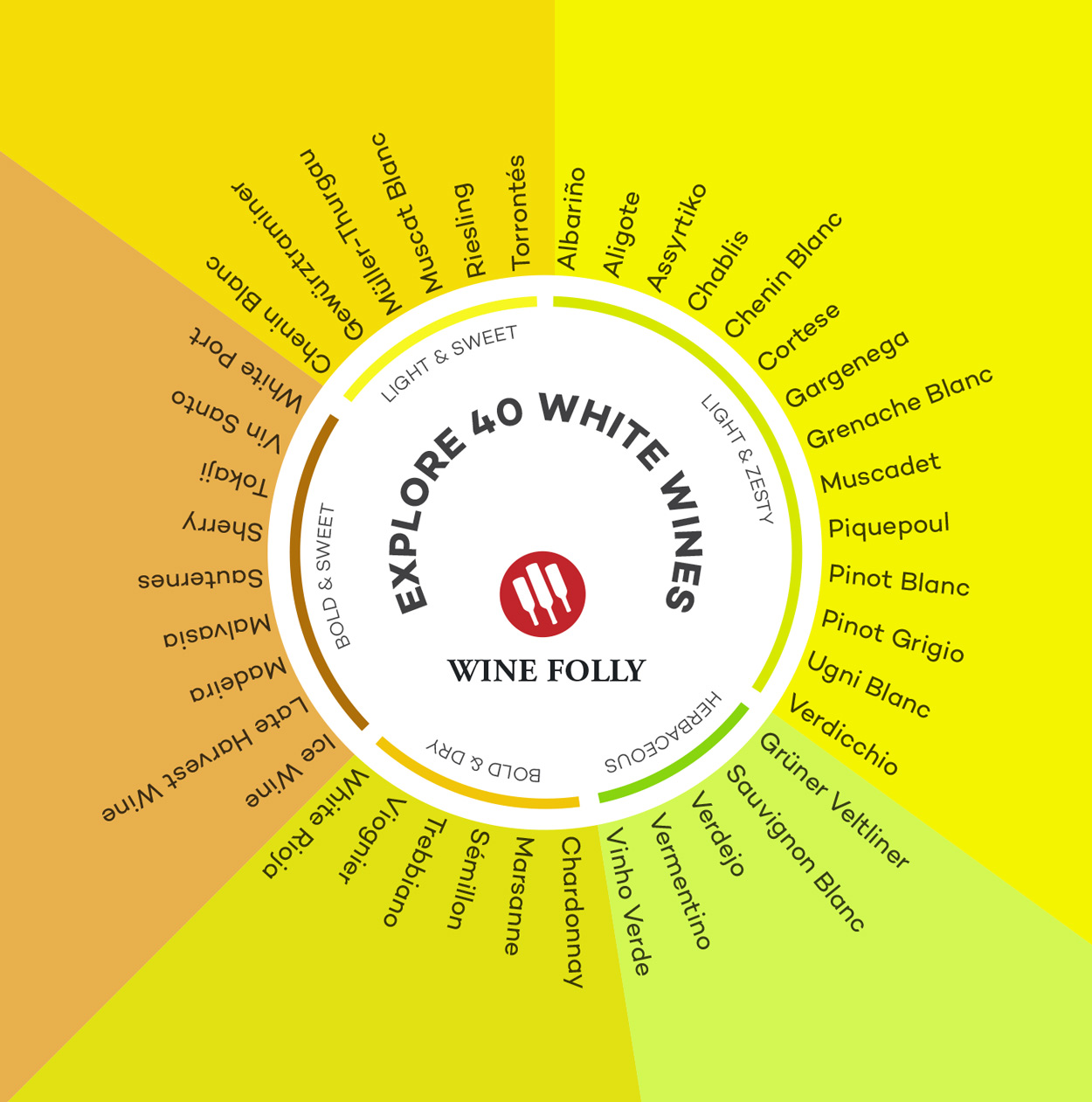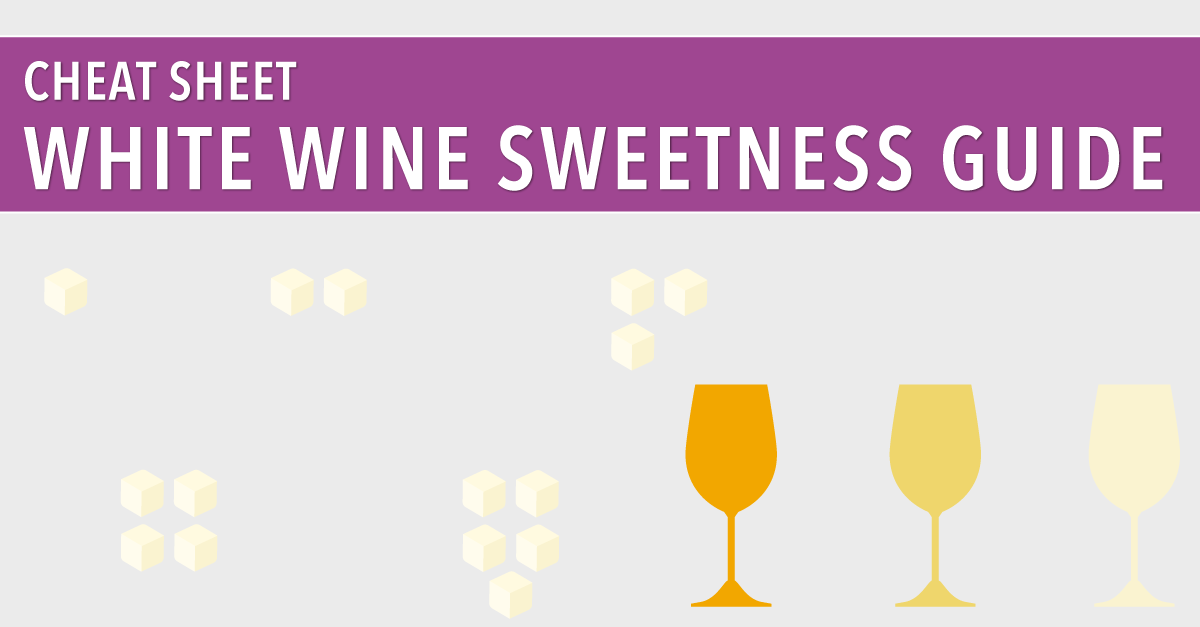
Wines From Dry to Sweet (Chart) Wine Folly
Winemakers often use terms like "dry," "off-dry," or "sweet" to signal the wine's sweetness level. But the real secret lies in the residual sugar (RS) content, measured in grams per liter (g/L). A wine with less than 4g/L is bone-dry, 4-12g/L is considered off-dry, and anything above 12g/L ventures into sweet territory.

Wine Sweetness Chart Wine Folly
(So useful!) When reading a tech sheet: Below 1% sweetness, wines are considered dry. Above 3% sweetness, wines taste "off-dry," or semi-sweet. Wines above 5% sweetness are noticeably sweet! Dessert wines start at around 7-9% sweetness. By the way, 1% sweetness is equal to 10 g/L residual sugar (RS).
Essential Wine Types Chart and Guide for Beginners Eat Play Wine
Certain white wines are almost always made dry — Sauvignon Blanc, Pinot Grigio, and Spanish Albariños. Many wines fall in the wide, wonderful world of medium-dry — Pinot Gris, Rieslings, and New World Chardonnays. As for perennially sweet wines, those might come from late-harvest grapes like Riesling and Chenin Blanc.

Wine Chart The Only Wine Sweetness Chart You’ll Ever Need Wine chart, Alcohol recipes, Wine
What Makes a White Wine Dry? The term "dry" does not indicate a wine without wetness. As a liquid, all wine is wet. Instead, dry refers to the sweetness present in a wine. All vino is rated based on this sweetness scale, with dry wines having far less sugar or residual sugar lingering behind after each taste.

wine chart I Love Wine
Published: March 23, 2015 Use our white wine sweetness cheat sheet as your guide. See the white wine sweetness chart for popular white wine varieties and regions.

Wine sweetness charts Boulogne Wine Blog
But first, what is the driest white wine? Dryness in wine refers to the absence of residual sugar. During the winemaking process, yeast consumes the grape's sugars, turning them into alcohol. The less sugar left behind, the drier the wine. To understand this, wines are categorized as follows on the sweetness scale: Sweet: High residual sugar.

Color Scale for Wines wine
1 The Difference Between Sweet and Dry White Wines 2 What is Residual Sugar, and Why is it Important? 3 Factors Affecting How We Perceive Sweetness in Wine 4 The Difference Between Fruity Wine and Sweet Wine 5 A Tannic Wine Doesn't Necessarily Equal a Dry Wine 6 White Wine Dryness Chart 7 White Wines Dryness Rankings 8

Wine Sweetness Chart Wine Folly
White Wines Wine Sweetness Scale Wine sweetness (or wine dryness) is determined not only by the amount of sugar in a wine, but also by acidity, alcohol content, and the presence of compounds called tannins. Below is an easy to read wine sweetness chart showing most popular varieties of red and white wines, and how sweet or dry they taste.

CHEAT SHEET White Wine Sweetness Chart & Guide VinePair
For white wines, pretty much only three regions in Europe traditionally make high quality off-dry or "harmoniously sweet" table wines: the Loire Valley (for Chenin Blanc), Pinot Gris, Riesling, Gewurtztraminer, and Muscat from Alsace in France, as well as much of the Riesling from Germany (although, there is also dry German Riesling).

Types Of White Wine Chart
Soave: Delicate, fragrant, sushi-friendly Italian white made from the garganega grape. Vinho Verde: Lightly sparkling, fragrant Portuguese blend from local grapes. Assyrtiko: A light but full-flavoured Greek white that tastes great with Halloumi cheese. Orvieto: Dry, round but fragrant Italian white, delicious with macaroni cheese or Greek salad.
Discover the 14 Driest White Wines (Dry to Sweet Wine Chart) Unraveling Wine
A dryness scale is a way of measuring the level of dryness in a wine. It is based on the amount of residual sugar left in the wine after fermentation. The more residual sugar, the sweeter the wine. The less residual sugar, the drier the wine. The dryness scale is used to classify wines according to their sweetness or dryness.

White Wine Sweetness Chart Cellars Wine Club
Types of dry white wine. Wines made from these common white wine grape varieties are generally dry. Though, again, certain producers' versions may be a little sweet to satisfy their particular customers. Albariño - This Spanish variety, most famously from the Rias Baixas region is typically bone dry.

Basic Guide to White Wine Wine Folly
Dry white wines include lemon and mineral flavors primarily and include options like Italian Pinot Grigio, Gavi, Muscadet, Vinho Verde, and Arinto.

White Wine Sweetness Chart (Printable!)
Wine Sweetness Chart Some wines are so dry that they scrape the moisture from your tongue and make the inside of your mouth stick to your teeth. On the other end of the spectrum, some wines are so sweet that they stick to the sides of your glass like motor oil. NEW GRAPHIC: The Wine Sweetness Chart poster has been updated on the store.

CHEAT SHEET White Wine Sweetness Chart & Guide VinePair
Dry White Wine List for People Who Like Sweet Wine White Wine Sweetness Chart We've organized the white wines here on a scale from dry to sweet. You'll find that there are more dry wines than sweet wines. In fact, most of the white wines that you're probably familiar with are dry white wines.

Wines Listed from Dry to Sweet (Charts) Wine Folly in 2020 Wine folly, Wine chart, White wine
Dry white wine is any white wine that does not taste sweet due to the low amount of residual sugar in the drink. Low amounts of residual sugar might be zero, 10 grams per liter, or as little as 4 grams per liter. A sugar concentration of one percent can also be considered dry.